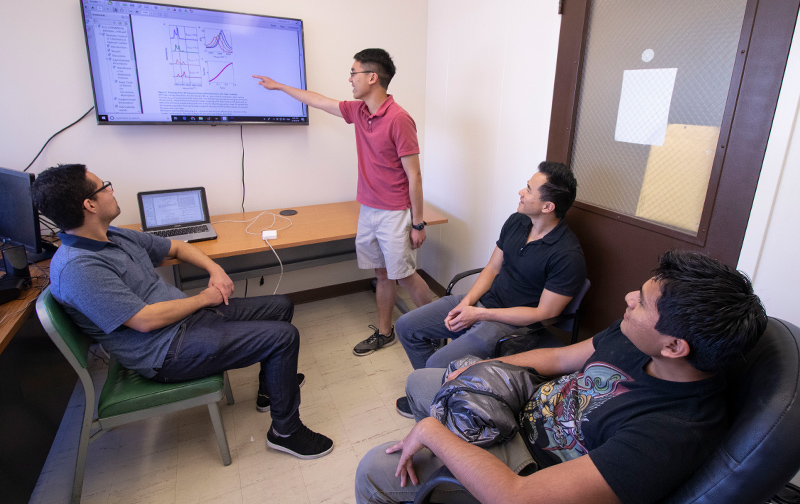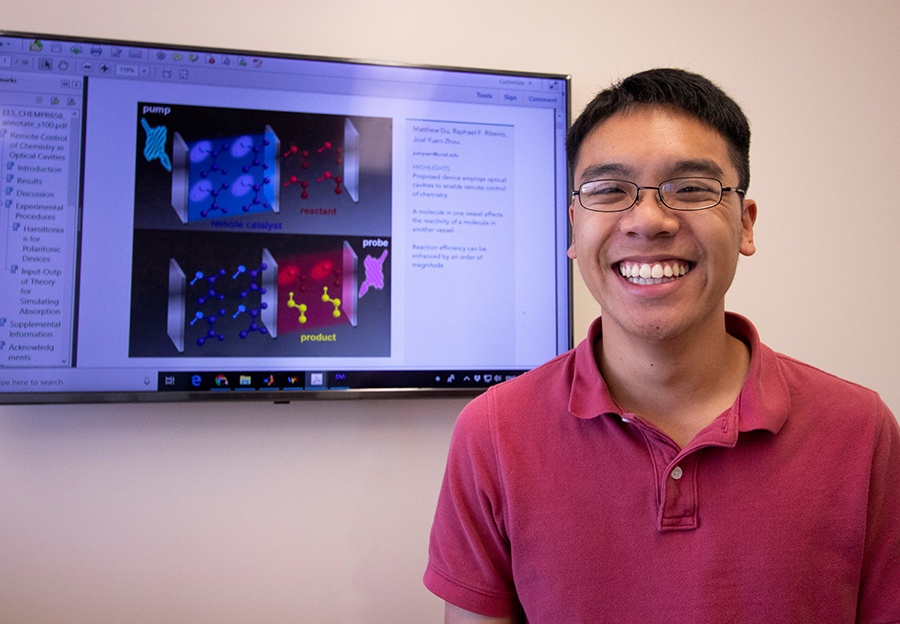Scientists ‘Game’ for Remote-control Chemistry of the Future
Researchers challenge chemistry lore, introduce new tool with “beautiful chain of events”
Published Date
By:
- Cynthia Dillon
Share This:
Article Content

Graduate student Matthew Du points to the “pink line,” indicating exciting results from the study. His colleagues Raphael Ribeiro (left), Joel Yuen-Zhou (top right) and Luis Martínez-Martínez look on. Photo by Michelle Fredricks, UC San Diego Physical Sciences
Many chemists have a dream: that one day they will be able to achieve full control of chemical reactions at atomic-level precision. The dream bears out chemistry’s long history of making and breaking chemical bonds through trial and error. But theoretical chemists at UC San Diego are beginning to see their dreams come true as they mix molecules and light in tiny black boxes, or “optical cavities.” Their promising study, titled “Remote Control of Chemistry in Optical Cavities,” was recently published in the Cell Press journal Chem.
Currently, students learn in high school that molecules need to be in physical contact with each other to do chemistry, but according to Assistant Professor of Chemistry and Biochemistry Joel Yuen-Zhou, “We are challenging the textbook conception of how chemical reactions happen.”
Yuen-Zhou worked with graduate student Matthew Du and postdoctoral scholar Raphael F. Ribeiro to theoretically and computationally design a novel quantum device that supports ultrafast—one millionth of a millionth of a second—tuning of chemical reactions between catalysts and reactants that are not in physical contact. In practical terms, imagine successfully mixing oil and water using soap except: (1) the soap does the job without being added to the liquids and (2) the mixing occurs in less time than a blink of an eye. This theoretical quantum engineering applied to chemical reactions, according to the researchers, is the next frontier in chemistry.

Matthew Du pictured in front of a presentation slide displaying the theoretical model of the two optical cavities. Photo by Michelle Fredricks, UC San Diego Physical Sciences
“We believe experimentalists will be able do this or a close variation of this quite soon,” Yuen-Zhou said. “It’s a natural step in the field.”
By exploiting the fact that light and matter can couple strongly and lead to changes in chemical reactions, the UC San Diego scientists proposed a device where a catalyst and reactant are separated from each other across several optical wavelengths between the two cavities. They then showed that photoexciting—increasing the energy of molecules by absorption of light—the remote catalyst in one optical box changes the photochemistry of the reactant in the other box.
Their theoretical work, which Yuen-Zhou refers to as pushing the envelope of the field, should apply to many other reactions, thus introducing a versatile tool to control photochemistry.
“This was a team effort,” noted Ribeiro, explaining that the results have implications for making the practice of chemistry more economical and time-efficient.
Du, first author of the research paper, said that it was rewarding to see everything—the right molecules, reactions, equations and physics involved—come together in a theory. “It was a beautiful chain of events,” he said.
This research was supported by a UC San Diego CRES postdoctoral award, the AFOSR (award no. FA9550-18-1-0289) and the US Department of Energy, Office of Science Early Career Research Program (award no. DE-SC0019188).
The Department of Chemistry and Biochemistry at UC San Diego is ranked among the nation’s top 20 programs according to U.S. News and World Report.Share This:
You May Also Like
UC San Diego is Strengthening U.S. Semiconductor Innovation and Workforce Development
Technology & EngineeringStay in the Know
Keep up with all the latest from UC San Diego. Subscribe to the newsletter today.



